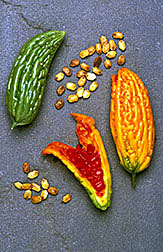 The Chinese melon produces seeds high in an enzyme that may be able to make soybean oil into a drying oil for paints and other coatings. (K7044-6) |
Melon Could Speed Soyoil Drying
Asians use the green Chinese melon, also known as bitter melon, as a health food, enjoying it in summer salads. Latin Americans eat it when the melon is golden-sweet, and they use the leaves to treat skin irritations.
But scientists at ARS' Southern Regional Research Center in New Orleans see the melon's seeds as a way to give soybeans a new use as an industrial oil.
Outside, the seeds of the Chinese melon come covered in a blood-red, jellylike package. Inside, the jagged brown seeds carry enzymes that may be able to convert soybean oil into a good drying oil for varnishes and coatings.
"We're trying to isolate the melon seed's enzyme—known as conjugated fatty acid synthetase—so we can enzymatically modify soybean oil to improve its drying characteristics," says chemist Min Kun Chang.
Currently, industry uses imported tung oil in paints, coatings, and other high-value products. But labor shortages and older, less, productive trees have caused the price to nearly triple—from 50 cents to $ 1.40 per pound.
Tung oil is high in eleostearic acid, the component that accelerates drying. But tung nuts and Chinese melon seeds also contain enzymes that can serve as a catalyst to convert the linoleic acid in soybean oil to eleostearic acid.
 South American tung nuts. (K7045-3) |
We are now experimenting with the enzymes," says chemist Dorselyn Chapital, "to see if either one works better to modify soybean oil." Then efforts will get under way to find a low-cost method lo mass-produce the best-performing enzyme by microbial fermentation.
The scientists hope it will be possible to tailor soyoil to both meet the paint and coaling industry's requirements for drying properties and comply with the Clean Air Act's emissions regulations. Such soy-based products would eliminate the need for volatile solvents currently used lo speed drying. Instead of releasing volatiles into the air, paints made with vegetable oil would dry by chemical cross-linking of eleostearic acid in me oil to create a finish-like coating.
Soybeans have long been used for food and as a feed crop, but adapting them to new industrial uses such as paints and coatings could greatly increase their value, says Chapital. — By Jill Lee, ARS.
"Melon Could Speed Soyoil Drying" was published in the April 1996 issue of Agricultural Research magazine.






